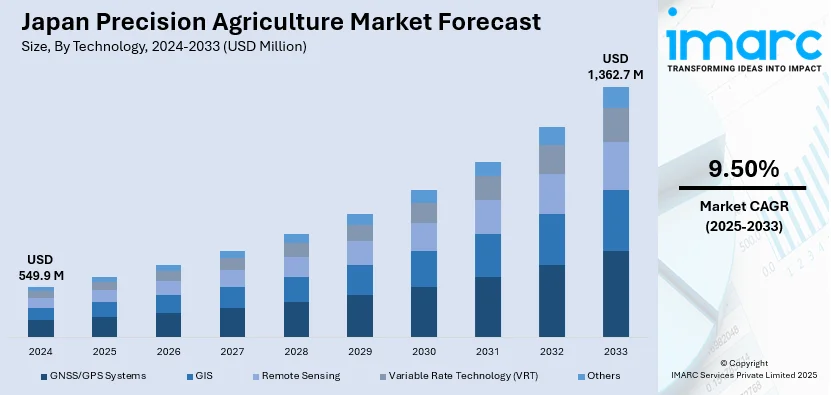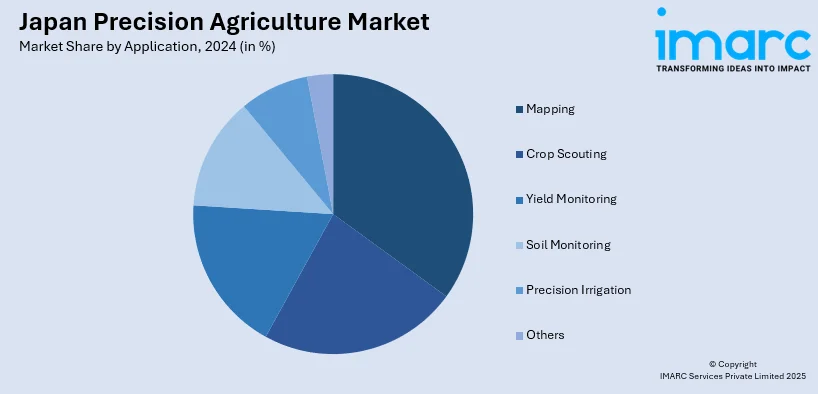
Japan Precision Agriculture Market Size, Share, Trends and Forecast by Technology, Type, Component, Application, and Region, 2025-2033
Japan Precision Agriculture Market Overview:
The Japan precision agriculture market size reached USD 549.9 Million in 2024. Looking forward, IMARC Group expects the market to reach USD 1,362.7 Million by 2033, exhibiting a growth rate (CAGR) of 9.50% during 2025-2033. The market is driven by an aging farming population, limited arable land, and government support for smart farming technologies. Urbanization and climate challenges also enhance the adoption of precision agriculture solutions. Rising demand for sustainable food production, advancements in IoT and AI, and the need for resource efficiency are further expanding the Japan precision agriculture market share.
|
Report Attribute
|
Key Statistics
|
|---|---|
|
Base Year
|
2024
|
|
Forecast Years
|
2025-2033
|
|
Historical Years
|
2019-2024
|
| Market Size in 2024 | USD 549.9 Million |
| Market Forecast in 2033 | USD 1,362.7 Million |
| Market Growth Rate 2025-2033 | 9.50% |
Japan Precision Agriculture Market Trends:
Adoption of IoT and AI Technologies in Precision Agriculture
The increasing adoption of IoT (Internet of Things) and AI (Artificial Intelligence) technologies is significantly supporting the Japan precision agriculture market growth. A research report released by the IMARC Group indicates that the artificial intelligence market in Japan was valued at USD 6.6 Billion in 2024. It is projected to grow to USD 35.2 Billion by 2033, reflecting a compound annual growth rate (CAGR) of 20.4% from 2025 to 2033. With IoT-enabled sensors, farmers are monitoring soil moisture, temperature, and crop health in real-time, which enables data-driven decision-making. AI-based analytics help in optimizing irrigation, fertilization, and pest control, thus reducing resource wastage and increasing crop yields. This trend is being promoted extensively by the Japanese government through subsidies and the promotion of smart farming, particularly in response to labor shortages in rural areas. Moreover, private firms are developing autonomous drones and robotics with a view to monitoring fields and accurately spraying fertilizers or treatment, considerably increasing efficiency. Japan is seeing a need for IoT and AI technologies amidst challenges including an aging agriculture workforce and less land for farming. This pattern is expected to accelerate, with more and more farms turning to advanced technologies to increase efficiency and reduce their environmental footprint.

Expansion of Vertical Farming and Controlled Environment Agriculture (CEA)
Another key trend in the market is the rapid expansion of vertical farming and Controlled Environment Agriculture (CEA). Japan's smart agri programs, such as the 'NoshoNavi1000' model, have shown an 87% reduction in working hours, a 20% reduction in fertilizer usage, and an above 30% increase in rice production. Japan is using 120 new technologies built for rice-growing to rethink productivity in the context of an evaporating workforce with artificial intelligence, the Internet of Things, and robotics. This technology facilitates the integration of indoor vertical farming and precision agriculture in Japan's cutting-edge agricultural sector. Reduced farmland and increased urbanization have resulted in a higher demand for space-efficient agricultural techniques, giving rise to indoor vertical farms utilizing hydroponics and aeroponics. These systems have advanced technologies such as LED lighting, automated nutrient delivery, and climate control, allowing them to optimize plant growth while reducing water and energy use. Japanese corporate behemoths and startups alike are making significant investments in vertical farming in order to provide a steady supply of high-quality leafy greens and herbs year-round, lessening their dependence on imports. Moreover, CEA helps address the challenges of climate change and extreme weather, examples of which can disrupt food supply chains. As consumer demand for local and pesticide-free produce continues to grow, there is room for further expansion within the vertical farming sector, and advances in automation and AI-based tracking systems are helping to support this growth. It is also in line with Japan’s measures on food security and sustainable agricultural practices. Therefore, this is further creating a positive Japan precision agriculture market outlook.
Japan Precision Agriculture Market Segmentation:
IMARC Group provides an analysis of the key trends in each segment of the market, along with forecasts at the country level for 2025-2033. Our report has categorized the market based on technology, type, component, and application.
Technology Insights:
- GNSS/GPS Systems
- GIS
- Remote Sensing
- Variable Rate Technology (VRT)
- Others
The report has provided a detailed breakup and analysis of the market based on the technology. This includes GNSS/GPS systems, GIS, remote sensing, variable rate technology (VRT), and others.
Type Insights:
- Automation and Control Systems
- Sensing and Monitoring Devices
- Farm Management System
A detailed breakup and analysis of the market based on the type have also been provided in the report. This includes automation and control systems, sensing and monitoring devices, and farm management system.
Component Insights:
- Hardware
- Software
The report has provided a detailed breakup and analysis of the market based on the component. This includes hardware and software.
Application Insights:

- Mapping
- Crop Scouting
- Yield Monitoring
- Soil Monitoring
- Precision Irrigation
- Others
A detailed breakup and analysis of the market based on the application have also been provided in the report. This includes mapping, crop scouting, yield monitoring, soil monitoring, precision irrigation, and others.
Regional Insights:
- Kanto Region
- Kansai/Kinki Region
- Central/ Chubu Region
- Kyushu-Okinawa Region
- Tohoku Region
- Chugoku Region
- Hokkaido Region
- Shikoku Region
The report has also provided a comprehensive analysis of all the major regional markets, which include Kanto Region, Kansai/Kinki Region, Central/ Chubu Region, Kyushu-Okinawa Region, Tohoku Region, Chugoku Region, Hokkaido Region, and Shikoku Region.
Competitive Landscape:
The market research report has also provided a comprehensive analysis of the competitive landscape. Competitive analysis such as market structure, key player positioning, top winning strategies, competitive dashboard, and company evaluation quadrant has been covered in the report. Also, detailed profiles of all major companies have been provided.
Japan Precision Agriculture Market News:
- February 27, 2025: Yamaha Motor of Japan launched Yamaha Agriculture to address labor shortages in specialty crop production with autonomous robotics and artificial intelligence. This effort comes following the company's purchase of Robotics Plus in New Zealand, as well as The Yield in Australia. As specialty growers continue to spend some USD 500,000 annually on automation, Yamaha hopes its new 'Prosper' hybrid vehicle for spraying, weeding, and yield forecasting will help to increase efficiency. This trend reinforces Japan's precision agriculture industry to address the rising demand for sustainable, data-focused agricultural solutions.
- February 19, 2025: Square Roots officially launched Square Roots Japan in Tokyo with its modular indoor vertical farming system that allows for year-round production of specialty crops while preserving traditional farming practices. This initiative combines precision agriculture technology with Japan's deep agricultural history, helping combat the challenges of climate change and demographic shifts. It is supported by a group of partners, including Gordon Food Service and the Gates Foundation. This initiative aims to scale climate-resilient, data-informed agriculture across all of Japan.
Japan Precision Agriculture Market Report Coverage:
| Report Features | Details |
|---|---|
| Base Year of the Analysis | 2024 |
| Historical Period | 2019-2024 |
| Forecast Period | 2025-2033 |
| Units | Million USD |
| Scope of the Report |
Exploration of Historical Trends and Market Outlook, Industry Catalysts and Challenges, Segment-Wise Historical and Future Market Assessment:
|
| Technologies Covered | GNSS/GPS Systems, GIS, Remote Sensing, Variable Rate Technology (VRT), Others |
| Types Covered | Automation and Control Systems, Sensing and Monitoring Devices, Farm Management System |
| Components Covered | Hardware, Software |
| Applications Covered | Mapping, Crop Scouting, Yield Monitoring, Soil Monitoring, Precision Irrigation, Others |
| Regions Covered | Kanto Region, Kansai/Kinki Region, Central/ Chubu Region, Kyushu-Okinawa Region, Tohoku Region, Chugoku Region, Hokkaido Region, Shikoku Region |
| Customization Scope | 10% Free Customization |
| Post-Sale Analyst Support | 10-12 Weeks |
| Delivery Format | PDF and Excel through Email (We can also provide the editable version of the report in PPT/Word format on special request) |
Key Questions Answered in This Report:
- How has the Japan precision agriculture market performed so far and how will it perform in the coming years?
- What is the breakup of the Japan precision agriculture market on the basis of technology?
- What is the breakup of the Japan precision agriculture market on the basis of type?
- What is the breakup of the Japan precision agriculture market on the basis of component?
- What is the breakup of the Japan precision agriculture market on the basis of application?
- What is the breakup of the Japan precision agriculture market on the basis of region?
- What are the various stages in the value chain of the Japan precision agriculture market?
- What are the key driving factors and challenges in the Japan precision agriculture market?
- What is the structure of the Japan precision agriculture market and who are the key players?
- What is the degree of competition in the Japan precision agriculture market?
Key Benefits for Stakeholders:
- IMARC’s industry report offers a comprehensive quantitative analysis of various market segments, historical and current market trends, market forecasts, and dynamics of the Japan precision agriculture market from 2019-2033.
- The research report provides the latest information on the market drivers, challenges, and opportunities in the Japan precision agriculture market.
- Porter's five forces analysis assist stakeholders in assessing the impact of new entrants, competitive rivalry, supplier power, buyer power, and the threat of substitution. It helps stakeholders to analyze the level of competition within the Japan precision agriculture industry and its attractiveness.
- Competitive landscape allows stakeholders to understand their competitive environment and provides an insight into the current positions of key players in the market.
Need more help?
- Speak to our experienced analysts for insights on the current market scenarios.
- Include additional segments and countries to customize the report as per your requirement.
- Gain an unparalleled competitive advantage in your domain by understanding how to utilize the report and positively impacting your operations and revenue.
- For further assistance, please connect with our analysts.
 Request Customization
Request Customization
 Speak to an Analyst
Speak to an Analyst
 Request Brochure
Request Brochure
 Inquire Before Buying
Inquire Before Buying




.webp)




.webp)












